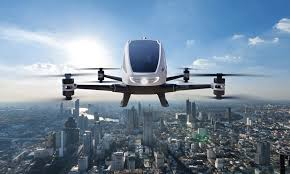In 2023, urban air mobility (UAM) is not just a futuristic concept; it’s becoming a reality that’s transforming our cities and redefining sustainable transport. According to a recent Bloomberg Green report, the global UAM market is expected to reach $15 billion by 2025, driven by advancements in electric vertical takeoff and landing (eVTOL) aircraft. This fast-evolving sector promises to revolutionize how we think about city travel, offering an eco-friendly alternative to traditional transportation methods. In this article, we’ll explore how urban air mobility is reshaping sustainable transport this year, delve into the technologies behind it, and consider its implications for the future of urban living.
The Rise of Urban Air Mobility in 2023
What is Urban Air Mobility?
Urban air mobility refers to the use of air taxis and drones to move people and goods within urban areas. These aircraft are usually electric or hybrid, aligning with global sustainability goals. With companies like Hyundai and Volkswagen announcing significant investments in eVTOL technology, UAM is set to take off—literally and figuratively.
Key Technologies Driving UAM
- Advanced eVTOL Aircraft: The backbone of UAM, these aircraft are designed for short-range flights and can operate autonomously or with a pilot. Companies like Volocopter and Joby Aviation are at the forefront, with prototypes already undergoing test flights.
-
Battery Innovation: As reported by Battery University, advancements in lithium-ion and solid-state batteries are crucial for the viability of eVTOLs, offering longer flight times and faster charging capabilities.
-
AI and Automation: AI technologies are pivotal in navigating urban environments safely. According to Wired, autonomous flying systems are being developed to manage air traffic and ensure efficient flight paths.
Benefits of Urban Air Mobility
-
Reduced Congestion: By shifting some transport to the air, UAM can alleviate traffic congestion on city roads.
-
Lower Emissions: Electric aircraft reduce carbon emissions, supporting cleaner urban environments and contributing to global climate goals.
-
Faster Commutes: With the ability to bypass ground traffic, air taxis can significantly reduce travel time across cities.
Urban Air Mobility: A Sustainable Future
How UAM Supports Sustainability
Urban air mobility aligns with the International Energy Agency’s (IEA) sustainability targets by providing a cleaner alternative to fossil-fuel-based transportation. The integration of renewable energy sources for charging infrastructure further enhances its green credentials.
- Renewable Energy Charging: New charging stations powered by solar and wind energy are being developed, ensuring that eVTOLs remain truly sustainable.
-
Lifecycle Emissions: Studies suggest that the lifecycle emissions of eVTOLs are significantly lower than those of traditional vehicles when powered by renewable energy sources.
Challenges and Considerations
While the potential of UAM is immense, several challenges need addressing:
- Infrastructure Development: Building the necessary vertiports and charging stations requires significant investment and urban planning.
-
Regulatory Hurdles: Governments must develop new regulations to manage airspace and ensure safety, as highlighted by a recent Reuters Mobility article.
-
Public Acceptance: Gaining the trust and acceptance of the public is crucial for widespread adoption. Clear communication about safety and benefits will be key.
Practical Tips for Embracing Urban Air Mobility
How to Experience UAM Today
-
Pilot Programs: Some cities, like Los Angeles and Seoul, are already hosting pilot programs. Check local government websites for participation opportunities.
-
Stay Informed: Follow industry leaders such as Volocopter and Joby Aviation through platforms like TechCrunch to stay updated on developments.
-
Advocacy and Feedback: Engage with local policymakers to advocate for sustainable transport solutions and provide feedback on urban air mobility initiatives.
Comparison: eVTOL vs. Traditional Transport
| Feature | eVTOL | Traditional Transport |
|---|---|---|
| Emissions | Low (electric) | High (fossil fuels) |
| Speed | Fast (avoids traffic) | Moderate (traffic delays) |
| Infrastructure | Developing (vertiports) | Established (roads) |
| Accessibility | Growing | Widely available |
Conclusion: The Future of Urban Air Mobility
Urban air mobility is poised to redefine sustainable transport in cities around the world. As technologies advance and infrastructure develops, eVTOLs offer a promising solution to urban congestion and pollution. The coming years will be crucial in addressing regulatory and public acceptance challenges. As we look to the future, the sky is not the limit—it’s the beginning. Share your thoughts on urban air mobility and join the conversation: How do you envision the future of sustainable urban transport?
By understanding the transformative power of UAM today, we can better prepare for a cleaner, faster, and more efficient tomorrow. Stay tuned to the latest developments in this exciting field and be part of the movement towards a sustainable urban future.

